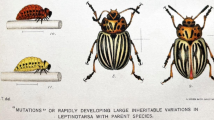Summary
The view is put forward that acquired adaptation of a very general nature could be inherited by system in which, when the growth rate of an organism is retarded by environmental conditions, the rate of reproduction of plasmagenes affecting that growth rate is retarded to a lesser degree or not at all. The consequent increased concentration of these plasmagenes is supposed to tend to restore the original growth rate (the organism thus becomes adapted to the new conditions). This leads to a new, higher, equilibrium concentration of the plasmagenes, and it is further supposed that this is passed on in reproduction to the next generation, which in this way inherits the adaptation.
It is further argued that rate of plasmagene reproduction is subject to control by nuclear genes, and that systems such as that suggested could have come into being by the ordinary processes of natural selection of nuclear genes.
Inheritance of acquired adaptations must be look ed for in general characters of growth and vigour, and not in specific characters such as those of morphology or behaviour.
Similar content being viewed by others
References
Crosby, J. L. (1955). The evolution of mitosis.Proc. Univ. Durham Phil. Soc. 8, 73–81.
Darlington, C. D. &Mather, K. (1949).The Elements of Genetics. London.
Hinshelwood, C. N. (1953). Adaptation in micro-organisms and its relation to evolution.Symp. Soc. Exp. Biol. 7, 31–42.
Preer, J. R. (1946). Some properties of a genetic cytoplasmic factor inParamecium.Proc. Net. Acad. Sci., Wash.,32, 247–53.
Salamaw, R. N. &Le-Pelley, R. H. (1930). Para-crinkle: a potato disease of the virus group.Proc. Roy. Sac. B,106, 140–75.
Simpson, G. G. (1953). The Baldwin effect.Evolution,7, 110–17.
Thoday, J. M. (1953). Components of fitness.Symp. Soc. Exp. Biol. 7, 96–113.
Waddington, C. H. (1952). Selection of the genetic basis for an acquired character.Nature, Lond.,169, 278.
Waddistgton, C. H. (1953). Genetic assimilation of an acquired character.Evolution,7, 118–26.
Author information
Authors and Affiliations
Rights and permissions
About this article
Cite this article
Crosby, J.L. A suggestion concerning the possible role of plasmagenes in the inheritance of acquired adaptations. J Genet 54, 1–8 (1956). https://doi.org/10.1007/BF02981696
Received:
Issue Date:
DOI: https://doi.org/10.1007/BF02981696




